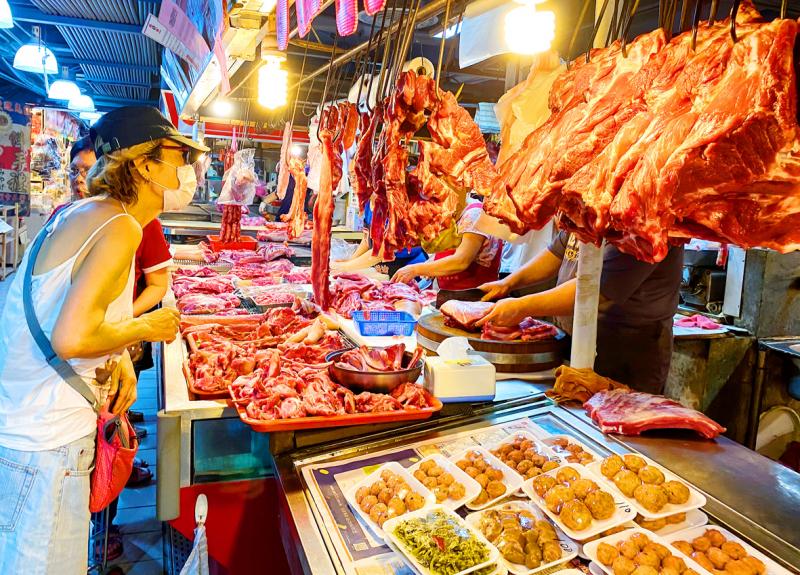A statistical study by National Cheng Kung University (NCKU) researchers concluded that eating some meat containing ractopamine posed a risk that was “within an acceptable range” for ordinary people, but cancer or heart disease risks were not assessed.
The study was released to provide backing for the government’s plan to relax imports of US pork containing the leanness-enhancing drug ractopamine to pave the way for closer trade ties between the two nations.
The move is controversial because the use of ractopamine is banned in Taiwan, and pork imports containing the drug have long been opposed because of potential safety issues.

Photo: CNA
According to the assessment by NCKU, the risks of eating beef or pork containing ractopamine were found to be acceptable based on maximum residue level (MRL) standards set by the Codex Alimentarius Commission.
The commission, which falls under the UN, is responsible for implementing international food standards. In 2012, it set MRL standards for ractopamine of 10 parts per billion (ppb) for pork and beef, and 40ppb in liver and 90ppb in kidneys.
Using a “hazard index” in its assessment, the NCKU team said that the non-cancer risk from eating beef, pork, and internal organs with ractopamine levels meeting the commission’s MRL standards was below one, meaning it was acceptable.
The index represents the ratio of the potential exposure to a substance, in this case ractopamine contained in meat consumed, and the level at which no adverse effects are reported, in this case the commission’s MRL standards.
The NCKU calculations for consumption were based on data available in the National Food Consumption Database, which gives consumption figures for people in Taiwan according to age and gender.
There was not enough scientific data to prove whether eating beef or pork containing ractopamine could cause cancer or heart disease in humans, the report said, adding that it therefore only ran simulations for non-cancer risk.
Controversy also surrounds the commission’s MRL standards as an indicator of how much ractopamine residue in meat can be considered to not have adverse effects.
The standards were adopted based on a 69-67 vote by the commission in July 2012, with the unusually narrow margin reflecting a lack of scientific consensus.
The European Food Safety Authority published a report in 2009 that criticized the data and methodology used by the commission to calculate the acceptable daily intake for ractopamine on which the MRL standarsds were based, a Food Safety News report written in July 2012 said.
The NCKU team did find a possible risk for women who have just had a baby and follow the local tradition of nursing themselves back to health by eating animals’ internal organs, especially kidneys and livers.
It said that if a woman eats more than 260g of pork kidneys and 360g of pork liver containing ractopmaine per day, it would increase the health risk to above one on the index, indicating a higher risk.
The NCKU report, dated February last year, was one of two assessments commissioned by the Council of Agriculture’s Agriculture and Food Agency that were on Saturday sent to lawmakers for their reference.
The other assessment was conducted by National Taiwan University in 2018, and assessed the risk for people of contracting mad cow disease by eating US beef.
The two were sent to lawmakers after President Tsai Ing-wen (蔡英文) on Friday announced that Taiwan would ease restrictions on US beef and pork imports, while setting standards for pork containing ractopamine.
The bans would be lifted on US pork containing ractopamine and beef from cattle more than 30 months old, which had been barred because of mad cow disease fears.

Chinese Nationalist Party (KMT) Chairman Eric Chu (朱立倫), spokeswoman Yang Chih-yu (楊智伃) and Legislator Hsieh Lung-chieh (謝龍介) would be summoned by police for questioning for leading an illegal assembly on Thursday evening last week, Minister of the Interior Liu Shyh-fang (劉世芳) said today. The three KMT officials led an assembly outside the Taipei City Prosecutors’ Office, a restricted area where public assembly is not allowed, protesting the questioning of several KMT staff and searches of KMT headquarters and offices in a recall petition forgery case. Chu, Yang and Hsieh are all suspected of contravening the Assembly and Parade Act (集會遊行法) by holding

PRAISE: Japanese visitor Takashi Kubota said the Taiwanese temple architecture images showcased in the AI Art Gallery were the most impressive displays he saw Taiwan does not have an official pavilion at the World Expo in Osaka, Japan, because of its diplomatic predicament, but the government-backed Tech World pavilion is drawing interest with its unique recreations of works by Taiwanese artists. The pavilion features an artificial intelligence (AI)-based art gallery showcasing works of famous Taiwanese artists from the Japanese colonial period using innovative technologies. Among its main simulated displays are Eastern gouache paintings by Chen Chin (陳進), Lin Yu-shan (林玉山) and Kuo Hsueh-hu (郭雪湖), who were the three young Taiwanese painters selected for the East Asian Painting exhibition in 1927. Gouache is a water-based

Taiwan would welcome the return of Honduras as a diplomatic ally if its next president decides to make such a move, Minister of Foreign Affairs Lin Chia-lung (林佳龍) said yesterday. “Of course, we would welcome Honduras if they want to restore diplomatic ties with Taiwan after their elections,” Lin said at a meeting of the legislature’s Foreign Affairs and National Defense Committee, when asked to comment on statements made by two of the three Honduran presidential candidates during the presidential campaign in the Central American country. Taiwan is paying close attention to the region as a whole in the wake of a

OFF-TARGET: More than 30,000 participants were expected to take part in the Games next month, but only 6,550 foreign and 19,400 Taiwanese athletes have registered Taipei city councilors yesterday blasted the organizers of next month’s World Masters Games over sudden timetable and venue changes, which they said have caused thousands of participants to back out of the international sporting event, among other organizational issues. They also cited visa delays and political interference by China as reasons many foreign athletes are requesting refunds for the event, to be held from May 17 to 30. Jointly organized by the Taipei and New Taipei City governments, the games have been rocked by numerous controversies since preparations began in 2020. Taipei City Councilor Lin Yen-feng (林延鳳) said yesterday that new measures by